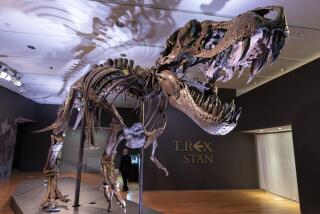Nanuqsaurus: This pygmy tyrannosaur prowled the ancient Arctic
How’s this for “death by cute?” Paleontologists have dug up a fearsome new dinosaur in a surprising place: Nanuqsaurus, a pygmy tyrannosaur that lived far away from its larger sharped-toothed cousins — in what is now Alaska.
The newly named Nanuqsaurus hoglundi fossil, described in PLoS ONE, reveals that dinosaurs lived in the Arctic 70 million years ago, during a much warmer period in Earth’s history.
“The discovery of Nanuqsaurus hoglundi provides new insights into tyrannosaurid adaptability and evolution in an ancient greenhouse Arctic,” wrote study authors Anthony Fiorillo and Ronald Tykoski of the Perot Museum of Nature and Science in Dallas.
Nanuqsaurus hoglundi may have been pint-sized compared with its well-known cousin Tyrannosaurus rex, but it was still a fearsome animal with a skull that stretched 25 inches. That’s small compared to T. rex’s skull, which was 5 feet long.
The fossil fragments of upper jawbone, lower jawbone, skull roof and braincase were dug out of the Prince Creek Formation on Alaska’s North Slope. This is highly unusual, given that most Tyrannosaur fossils are unearthed around or below southern Canada and central Asia, much closer to the equator.
With so little of the body to compare, it was possible that this relatively tiny carnivore was simply a juvenile, still-growing member of another Tyrannosaur species. But the bones seemed to be a weird mashup of characteristics of a number of different tyrannosaurid species and didn’t fit into the right time frame to be a species like T. rex or Daspletosaurus torosus.
Around this time, 70 million years ago, North America was divided into eastern and western continents by the Western Interior Seaway, which cut off many dinosaur populations. The east-west trending Brooks Mountain range may have further separated some northern and southern populations in the western continent (known as Laramidia). Over time, this isolation probably allowed many species to differentiate and may have accounted for the diversity of Tyrannosaurs. Nanuqsaurus would be no exception.
The researchers think that Nanuqsaurus is small because it lived so far north and in areas that were far less dependably warm year-round than the areas closer to the equator. Of course, Alaska was probably pretty cozy by our standards then, but it also had seasonal swings, and the winters were probably much more difficult times to find food. And in times of scarcity, a big animal is much harder to feed than a little one. Hence Nanuqsaurus’ small size: It was a way to deal with these seasonal swings.
“The smaller body size of Nanuqsaurus hoglundi may reflect that in the profoundly seasonal ancient Arctic environment where the widely varying light regime affected biological productivity, resource availability was limited.”
ALSO:
Meet RoboClam, a digging robot inspired by the razor clam
Kepler’s comeback? New K2 mission could chase wilder targets
Smile! Sharks with cameras capture their underwater world on video
Cute yet creepy? Somersaulting cube robots self-assemble







